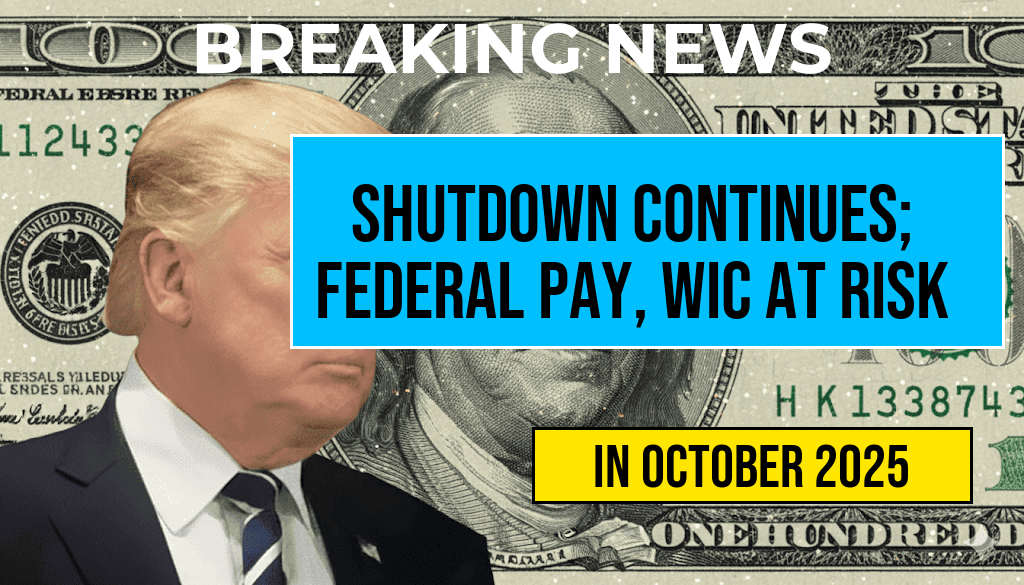Shutdown Continues into Day Six as Federal Employees Face Zero Paychecks and $8 Billion WIC Assistance Dwindles
The partial government shutdown enters its sixth day with no immediate resolution in sight, leaving hundreds of thousands of federal employees without pay and critical assistance programs like the Women, Infants, and Children (WIC) nutrition service facing significant funding shortfalls. As lawmakers debate funding bills, federal workers across agencies remain in limbo, enduring financial strain without paychecks, while vulnerable populations relying on WIC benefits confront potential cuts that could impact nutrition support for millions of families nationwide.
Impact on Federal Employees and Essential Services
Since the shutdown began, approximately 420,000 federal employees have been furloughed, and another 200,000 are working without pay, according to the Office of Personnel Management. Many of these workers, including TSA agents, air traffic controllers, and border patrol agents, continue their duties to maintain national security and public safety but are doing so without compensation. The lack of pay has caused widespread financial hardship, with some employees forced to dip into savings or seek emergency assistance.
Federal agencies have limited operations during the shutdown, with many services suspended or delayed. Processing of federal loan applications, visa services, and public land management remain on hold, disrupting both individual plans and broader economic activities. Notably, the Department of Housing and Urban Development (HUD) and the Department of Agriculture have scaled back programs that provide essential services to vulnerable populations.
WIC Program Faces Funding Shortfall Amidst Rising Demand
| Funding Level | Amount (Billions) | Projected Duration |
|---|---|---|
| Initial Allocation | $8 billion | Until late January 2024 |
| Remaining Funds | Approximately $2 billion | Varies depending on demand and expenditures |
One of the most immediate concerns linked to the shutdown involves the WIC program, which provides nutrition assistance to pregnant women, new mothers, infants, and young children. Originally allocated $8 billion for the fiscal year, the program has seen dwindling funds as administrative costs and increasing caseloads strain the remaining budget. Federal officials warn that unless Congress intervenes promptly, WIC services could face reductions as early as next month, jeopardizing essential nutritional support for nearly 7 million families.
WIC clinics across the country report delays in issuing benefits, with some states halting new enrollments or reducing the amount of assistance provided. These disruptions threaten to exacerbate food insecurity among low-income households, especially amid rising grocery prices and inflationary pressures that already strain household budgets.
Political Deadlock Deepens the Crisis
The ongoing impasse stems from partisan disagreements over funding priorities, with negotiations stalled over issues such as border security and immigration policies. Despite bipartisan acknowledgment of the human toll, negotiators remain at an impasse, delaying any agreement to reopen the government fully.
Senate leaders have proposed temporary funding measures to keep essential services operational and provide back pay once the shutdown ends, but these proposals face stiff opposition in the House. Lawmakers continue to trade blame, with some accusing the other side of prioritizing political objectives over the welfare of federal workers and vulnerable populations.
Economic and Social Consequences
The shutdown’s economic impact extends beyond federal employees. Local businesses that rely on federal contracts or services are experiencing declines in revenue, and the delay in government payments is affecting contractors and suppliers. The Congressional Budget Office estimates that the ongoing shutdown could shave off approximately $3 billion from the gross domestic product (GDP) during the first two weeks alone, with broader implications for economic growth.
Public health and safety remain at risk as agencies like the Centers for Disease Control and Prevention (CDC) operate with limited staff. The shutdown hampers preparedness efforts, disease surveillance, and emergency response activities, further complicating ongoing public health challenges.
Looking Ahead
As pressure mounts from advocacy groups, business leaders, and affected families, federal officials call on lawmakers to reach an agreement swiftly. The Biden administration has emphasized the importance of protecting the most vulnerable and ensuring that essential government functions continue uninterrupted. Meanwhile, federal workers await a resolution that will allow them to receive overdue pay and restore full services.
For now, the shutdown underscores the delicate balance between political negotiations and the everyday lives of millions. The coming days will be critical in determining whether Congress can bridge the divide and end the stalemate before further harm occurs.
Stay informed on developments by visiting reputable sources such as the Wikipedia page on U.S. government shutdowns and official statements from the Office of Personnel Management.
Frequently Asked Questions
What is the current status of the government shutdown?
The government shutdown has now entered its sixth day, affecting numerous federal agencies and services nationwide.
How are federal employees being impacted by the shutdown?
Many federal employees are not receiving paychecks during this shutdown, leading to financial uncertainty and hardship for affected workers.
What is happening to the WIC assistance program during the shutdown?
The WIC assistance program, which provides nutritional support to women, infants, and children, is facing a reduction of $8 billion, risking significant cuts in aid for vulnerable populations.
What are the reasons behind the government shutdown?
The shutdown is primarily due to a disagreement over federal funding priorities, preventing Congress from passing a new budget or continuing resolution.
When might the government shutdown end?
The duration of the shutdown remains uncertain, depending on negotiations in Congress; no specific end date has been announced.

Leave a Reply